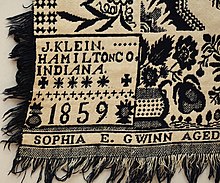Woven coverlet
Awoven coverletorcoverlid(derived fromCat.cobre-lit[1]) is a type ofbedcovering with awovendesign in coloredwoolyarnon a background of naturallinenorcotton.Coverlets were woven in almost every community in the United States from thecolonial erauntil the late 19th century.[2]
History
[edit]
Coverlets of 18th century America weretwill-woven with a linenwarpand woolenweft.The wool was most oftendyeda dark blue fromindigo,butmadderred,walnutbrown,[2][3]and a lighter "Williamsburgblue "were also used.


From the turn of the 19th century, simple twill-woven coverlets gave way to patterned hand-woven coverlets made in two different ways:[2]
- Overshot weave coverletswere made with aplain wovenundyed cotton warp and weft and repeating geometric patterns made with a supplementary dyedwoolenweft. Made on a simple four-harnessloom,overshot coverlets were often made in the home and remained a common craft in ruralAppalachiainto the early 20th century.[4]

- Double-cloth coverletsweredouble-woven,with two sets of interconnected warps and wefts, requiring the more elaborate looms of professional weavers. Wool for these coverlets was spun (and often dyed) at home and then delivered to a local weaver who made up the coverlet.[2]
Summer-winter coverlets were reversible, and the summer-winter term refers to the structure not the color. The summer-winter coverlet should not be confused with double weave and is more closely related to overshot. Like double weave, it is dark on one side and light on the other but there is only one layer of cloth, therefore it is much lighter in mass and thickness.
Following the introduction of thejacquard loomin the early 1820s, machine-woven coverlets in large-scale floral designs became popular.[5]
See also
[edit]
Notes
[edit]- ^Wedgwood, Hensleigh(1855)."On False Etymologies".Transactions of the Philological Society(6): 70.
- ^abcdWeissman, Judith Reiter and Wendy Lavitt:Labors of Love: America's Textiles and Needlwork, 1650-1930,New York, Wings Books, 1987,ISBN0-517-10136-X,p. 80-97
- ^American Woven “Coverlids”
- ^Allstand Cottage Industries brochureat the Hunter Library Digital Collections, retrieved 20 June 2007
- ^Coverlets Special Exhibit
References
[edit]- Weissman, Judith Reiter and Wendy Lavitt:Labors of Love: America's Textiles and Needlwork, 1650-1930,New York, Wings Books, 1987,ISBN0-517-10136-X
- Allstand Cottage Industries brochureat the Hunter Library Digital Collections, retrieved 20 June 2007
- Kelly, Andrew:Kentucky by Design: The Decorative Arts and American Culture,Le xing ton, University Press of Kentucky, 2015,ISBN978-0-8131-5567-8
- MADISON ALCEDO,DIY Chunky Knit Blanket Tutorials For Mastering the Cozy Viral Trend
External links
[edit]- Coverlets Special Exhibit(1830s-1870s) theAllison-Antrim Museum,Greencastle, Pennsylvania
- Illinois Jacquard Coverlets and Weavers
- Illinois Jacquard Coverlets and Weavers: End of a Legacy
- Craft Revival: Shaping Western North Carolina Past and Present - Coverlets
- The National Museum of the American Coverlet - Bedford, PA

